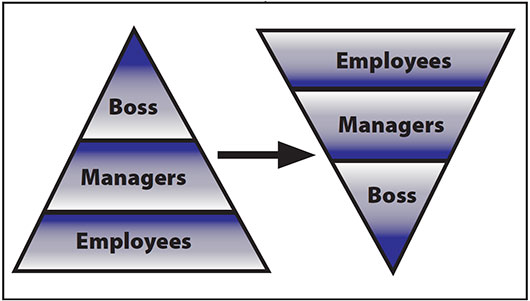Articles written by guest contributors

Throwing the organizational model on its head
By William IrvingWhat would happen if you flipped your organizational chart on its head? Would you view your position and how you manage your employees differently?
Sometimes, we get wrapped up in our position in the company, and the feeling of how that alone should garner the respect employees “under us” should be giving, versus the true responsibility of our role as leaders. As leaders we have a responsibility to do everything within our power to support our employees, to equip each of them with the tools they need to do the job, and to not get hung up on our title as the “boss.”
It’s easy for us as bosses to get frustrated when the results of our employees’ work is not in line with our expectations. When we don’t get the results we want, we have to reflect on how we communicated and maybe how our employees interpreted that communication.
The boss that says, “I’ll just do it next time,” is missing the opportunity in the moment to be the leader; a leader must reflect on what they could have done differently to support their team, so the future result will meet and hopefully exceed expectations. This is where the long-term success of a healthy growing company lies.
The inverted pyramid organizational model illustrates that a company’s foundation lies in how we lift up our team. Do we proactively prepare employees for the job? Do we understand how to best communicate with each unique employee? Do we set clear expectations and finally hold them accountable so they understand that you mean what you say?
Hand-holding early on minimizes hand-holding for future projects, but only if we are consistently investing, coaching and re-enforcing our employees’ work.
Employees look to us to be the “head coach,” someone who is going to set them up to be successful in the job. It’s critical to recognize that team members have different strengths and weaknesses you can use towards the overall strength of your team. Your team depends on you to provide them with a winning strategy, training and encouragement.
Realizing that everyone learns differently is the first step. Once you understand that your employees may not think the way you do, and may have very different needs and desires from you, it’s easier to understand how to make each of them successful. While not all employees’ motivations are the same, most start out wanting to be successful and their success translates directly into your success.
At the end of the day, who does not want to be positioned for success? If you worked for a supervisor who embodied the belief that success was based on how they positioned you (and at times repositioned you) for success on each project, would you not follow that person anywhere?
Success starts at the top – or in this case, the bottom. Ultimately, the top of your company is only as good as the top of your inverted pyramid. If you are not spending the time to be the coach – who makes the entire team successful – then maybe it’s time to reevaluate your management strategy.
William Irving is President of the Nantahala Outdoor Center (NOC) where he heads a staff of 750 seasonal and year-round employees. William's passion for human performance, taking a team approach and maximizing potential has led the NOC to record breaking revenue and profit over the last 6 years.















